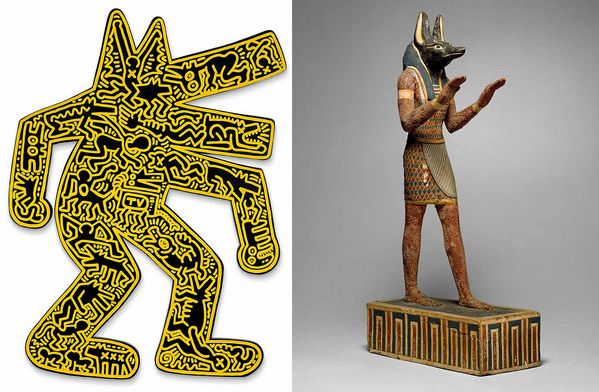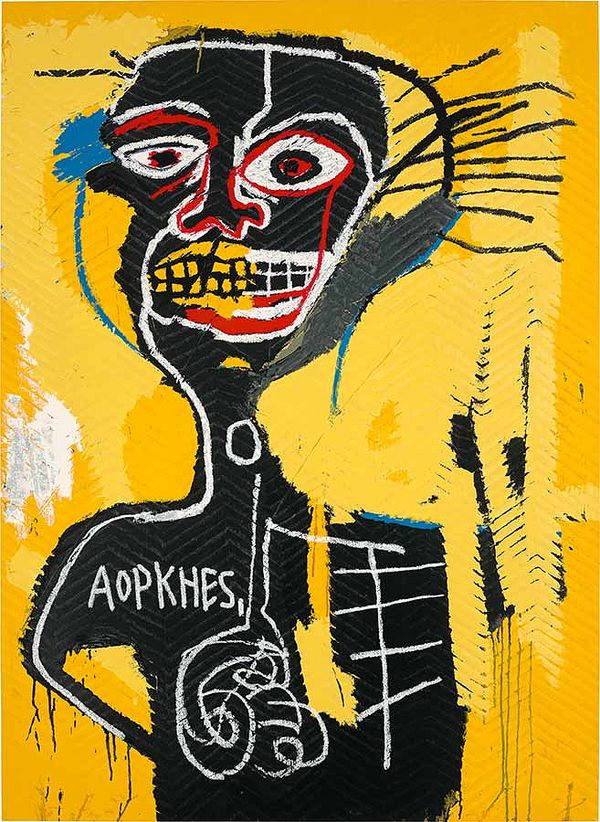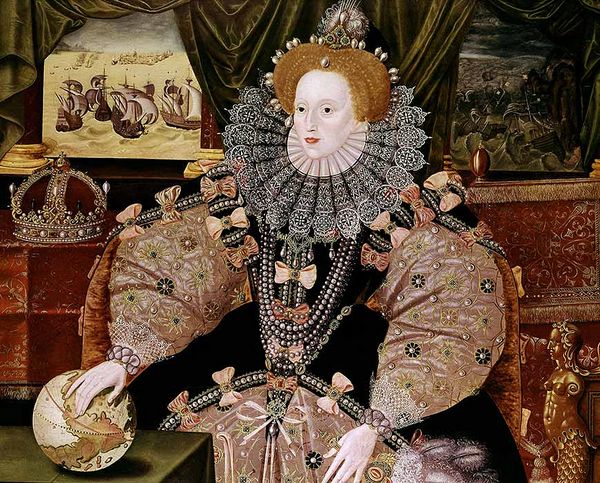Keith Haring, Dog, 1986. Evening & Day Editions London.
If for some strange reason you’d like to spoil a perfectly good and oddly specific night out, simply ask a historian when modernity begins. You might do the same for the writers, philosophers, and scientists in the room, and should you crawl out from under the dust cloud of limbs and expletives, it would be wise to spend the rest of the evening with an artist for their input: early man painted his dinner on a cave wall and we’ve been dealing in myths and abstractions of the mind ever since. Let the others argue dates — it's in the creative act that we find deep connections between the ancients and the moderns.
Finally, some conversation. How then does that act play out? For the answer, we turn to three artists featured in our upcoming London Evening & Day Editions Sale who flatten the temporal arc and, in the words of Joseph Campbell, “keep myth alive” through invention.
Keith Haring Builds a Mausoleum
Left: Keith Haring, Dog, 1986. Evening & Day Editions London. Right: Statuette of Anubis, 332-330 B.C., The Metropolitan Museum of Art, New York. Image: © The Metropolitan Museum of Art, New York, Gift of Mrs. Myron C. Taylor, 1938.
My drawings don’t try to imitate life; they try to create life, to invent life.
—Keith Haring
Among the most recognizable symbols in Keith Haring’s hieroglyphic alphabet is the barking dog, whose iconography speaks to deliverance in its domesticated and sublimated forms. Various breeds appear in Ancient Egyptian art in the former category, however there were only two words to describe them: iwiw for “barking dog” and tesem for “barkless dog,” or hunting varieties. In their divine incarnation, Anubis presides over funeral rites and guides the dead to the underworld. Haring brilliantly combines the two with wry multiplicity in Dog. If a quiet dog hunts, a barking dog protects; where Anubis embalms, the mummy is granted access to the afterlife. Haring’s Dog is a tomb unto itself, filled with symbols of Haring’s charged era – race and class-fueled public health campaigns in New York for dog owners to clean up after their pets and “put children before dogs” at a time when AIDS was an unspeakable taboo in the media and gay liberation was met with deadly political silence. With Dog, Haring gives presence, voice, and absolution to those who have been dehumanized, muted, and denied, all in a simple, profound visual language that flows between the Nile and the Hudson seamlessly.
After Jean-Michel Basquiat, the Flood
After Jean-Michel Basquiat, Cabeza, from Portfolio II, 1982/2004. Evening & Day Editions London.
I don't think about art when I'm working. I try to think about life.
—Jean-Michel Basquiat
Jean-Michel Basquiat’s insatiable hunger for information allowed the artist to find inspiration everywhere, appropriating references from any source in the development of his own personal iconography. A voracious consumer of books and images, Basquiat was known for his remarkable ability to absorb and reframe ideas into wholly new visual devices, as seen in Cabeza, from the Portfolio II series. Its focus is tagged AOPKHES, rendered with a name badge as if it were a forgotten deity attempting to re-emerge in our contemporary consciousness. The name appears in several of the artist’s works, read like approximated Greek and taken in the manner of meeting an incomprehensible subject. Beyond a system of objects and icons, Basquiat presents here a brilliant example of how the artist annexes images, often liberating them from their historical logic and diving straight into the act of creation as the source of deeply human inspiration.
Basquiat strolls through the museum gallery as a means of encountering the image – in this work we see a combination of portrait, totem, and trophy, and its representation bears hallmarks of the input-output model of information and production: ochre, the oldest pigment in art, and a name, the signifier of identity. Today, decades after Jean-Michel Basquiat, we might prompt an image-based AI to make words and find that it can only “imagine” letters as lines and shapes, which often results in incoherent, inhuman images – ones not inspired by a drive towards creation, but rather one intent on systematizing it into knowable elements. It is in this experience of finding gaps in what we can and cannot understand that we continue to find immediacy in Basquiat’s work.
Andy Warhol's Success(ion) Plan
Andy Warhol, Queen Elizabeth II of the United Kingdon, from Reigning Queens, 1985. Evening & Day Editions London.
The idea is not to live forever; it is to create something that will.
—Andy Warhol
Andy Warhol’s fascination with mass replication and consumption of celebrity found its pinnacle with Queen Elizabeth II. By 1985, when the work was created as part of the Reigning Queens series, the Queen had long since celebrated a Silver Jubilee, which included a photograph taken in 1975 by Peter Grugeon that became something of an ultimate image of the monarch. Across everything from consumer goods to currency, the fact that the photo was a decade old at the time spoke to its ubiquity, and Warhol seized the opportunity to capture the image in his trademark Pop aesthetic. Stylized with bold lines, bright colors and flat, graphic form, Warhol’s portrait is as much a portrait of the monarch as it is of late-twentieth-century pop culture, or postmodernity as it came to be known.
George Gower, Elizabeth I (Armada Portrait), c. 1588, Woburn Abbey, Bedfordshire. Image: Archivart / Alamy Stock Photo.
Even within this context, we find the pull of the past. Dressed in the Vladimir tiara, Queen Victoria’s Golden Jubilee necklace, Queen Alexandra’s wedding earrings, and King George VI’s Family Order pinned to her Garter sash, Warhol’s subject is adorned with her heritage. In the artist’s hands, however, the image of the Queen becomes reproducible and multipurpose as part of a relationship with its own circulation – symbolic power cedes itself to the usefulness of myth. The image becomes the real thing through its rapid, constant repetition. In this way, the artist removes the weight of legacy from Elizabeth’s image and instead offers a Warholian bargain: live forever, but the image dictates the terms. Such is the staying power of an icon.
Recommended Reading
La Joie de Vivre: How Picasso Embraced the Unpredictability of Ceramics >




